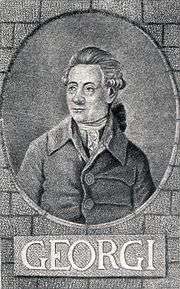Johann Gottlieb Georgi

Johann Gottlieb Georgi (31 December 1729 – 27 October 1802) was a German botanist, naturalist and geographer.
A native of Pomerania, Georgi accompanied both Johan Peter Falk and Peter Simon Pallas on their respective journeys through Siberia. During 1770-1774 he travelled on its behalf to Astrakhan, the Urals, Bashkir, the Barabinsk steppe, the Kolyvanskoe silver mines (to assess the ore content), Altai, Tomsk, Irkutsk, Baikal, and Dauren. In 1783 he became an academician of the Russian Academy of Sciences in St Petersburg.[1]
Georgi was particularly interested in the Baikal region. Based on collections from far eastern Russia, in his 1775 publication Bemerkungen einer Reise im Russischen Reich im Jahre 1772, Georgi provided the first botanical descriptions of many of the region's flowering plants, among them the Baikal Scullcap (S. baicalensis.) Many of these plants and herbs were later collected by European botanists in China, and thereafter became rare specimens in European botanical gardens.[2]
After his fellow botanist and travelling companion Falk took his own life in 1774, Georgi edited his notes which were published in Germany in 1785 as Beyträge zur topgraphischen Kentniss des russischen Reichs I.III.
In 1790, Georgi's German work of the description and urban plans of the city of St. Petersburg was published. It appeared in a second edition in Riga in 1793, and was finally translated into Russian a year later. His Geographisch-physikalische und Naturhistor. Beschreibung des Russ. Reiches, a nine volume edition of the geography and natural history of the Russian Empire, was published in Königsberg, Germany during 1797 - 1802.
References
- ↑ Aaloe, Aasa; Bauert, Heikki; Soesoo, Alvar (2007). "Kukersite oil shale" (PDF). Tallinn: MTÜ GEOGuide Baltoscandia: 29. ISBN 978-9985-9834-2-3. Retrieved 2013-03-16.
- ↑ Foster, S., C. X. Yue; Herbal Emissaries: Bringing Chinese Herbs to the West, Rochester, Vt: Healing Arts Press, 1992.
- ↑ IPNI. Georgi.